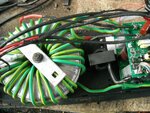Okada
Banned
This is regarding 12V to 230V Output transformer based Push-Pull Inverter.
Here in this link
https://www.instructables.com/id/250-to-5000-watts-PWM-DCAC-220V-Power-Inverter/
he mentions
For every 1amp of 220vAC you will be draining like 8 to 10 Amps from the 12v battery, make your calculations
So, If I design a 500VA or 500W Inverter then Output current (230V side) will be I = P/V = 500W/230V = 2.174A
So, approx 21.74A current is drawn from the 12V battery.
So, I can safely use ACS712-30A to monitor the battery current in Inverter mode and also while battery is charging. Right ?
because during full load 22A will be flowing in the battery circuit and during battery charging 10 to 14A current will be flowing.
Right now, I have ordered one 12-0-12V to 230V 500VA transformer for Inverter and another 230V to 12V 10A step down transformer for battery charging.
I have also ordered Rigol 1054Z Oscilloscope. I will get them in 4 weeks.
I will build the Inverter and post all voltages, currents and signals data here.
Here in this link
https://www.instructables.com/id/250-to-5000-watts-PWM-DCAC-220V-Power-Inverter/
he mentions
For every 1amp of 220vAC you will be draining like 8 to 10 Amps from the 12v battery, make your calculations
So, If I design a 500VA or 500W Inverter then Output current (230V side) will be I = P/V = 500W/230V = 2.174A
So, approx 21.74A current is drawn from the 12V battery.
So, I can safely use ACS712-30A to monitor the battery current in Inverter mode and also while battery is charging. Right ?
because during full load 22A will be flowing in the battery circuit and during battery charging 10 to 14A current will be flowing.
Right now, I have ordered one 12-0-12V to 230V 500VA transformer for Inverter and another 230V to 12V 10A step down transformer for battery charging.
I have also ordered Rigol 1054Z Oscilloscope. I will get them in 4 weeks.
I will build the Inverter and post all voltages, currents and signals data here.

